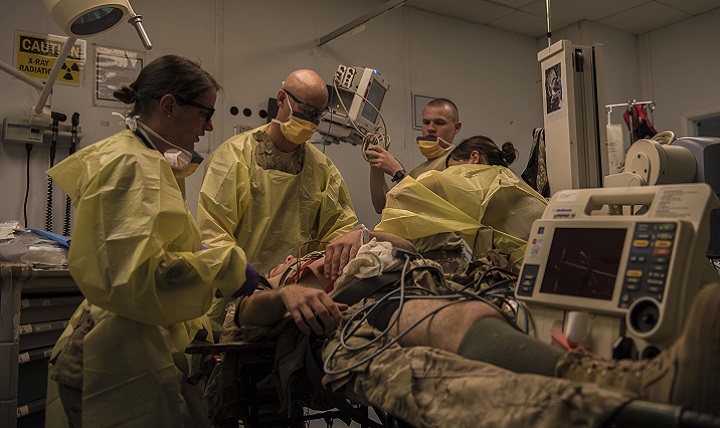Recommended Content:
Health Readiness, Military Hospitals and Clinics
BAGRAM AIRFIELD, Afghanistan — The sounds of controlled chaos echo throughout the halls and rooms of the Craig Joint Theater Hospital. Doctors, nurses, medical technicians, and hospital staff all rushing to take care of those critically injured.
Medical professionals at the Craig Joint Theater Hospital were put to the test during a recent mass casualty response exercise. In a joint effort between U.S. Air Force, Army, and coalition partners, the medical staff was able to test the response and capabilities to handle large amounts of injured patients.
“It’s important because it gets us to practice our skills, keeps us current and helps us see what we could potentially see out here,” said Air Force Capt. Chan Rajaram, 455th Expeditionary Medical Group, officer in charge, medical logistics.
Individuals were moulaged, a technique of applying mock injuries to healthy individuals, in order to provide a realistic scenario for emergency response teams. Those individuals were then placed at a location where the simulated emergency took place.
Once the exercise kicked off, U.S. Army Dustoff crews rushed into action beginning casualty evacuation operations. In a joint effort, Dustoff crews responded utilizing UH-60 Blackhawks to pick up critically injured patients and transported them back to Craig Joint-Theater Hospital.
Awaiting the arrival of the helicopters and ambulances, a once quiet hospital became a very busy place. Medical teams rushed to preposition stretchers and to prepare the emergency and operating rooms for the inbound patients.
“Typically when patients come off an aircraft, you want to start to triage them as quickly as possible and categorize them as quickly as possible,” says Air Force Capt. Rebekah Lockwood, 455th Expeditionary Medical Group critical care nurse.
 Members of the 455th Expeditionary Medical Group assess a mock victim during a mass casualty exercise at Bagram Airfield, Afghanistan, May 21, 2016. This exercise was conducted to test the medical readiness and skills of the squadron during an emergency to sharpen operational readiness. (U.S. Air Force photo by Senior Airman Justyn M. Freeman)
Members of the 455th Expeditionary Medical Group assess a mock victim during a mass casualty exercise at Bagram Airfield, Afghanistan, May 21, 2016. This exercise was conducted to test the medical readiness and skills of the squadron during an emergency to sharpen operational readiness. (U.S. Air Force photo by Senior Airman Justyn M. Freeman)
After an initial evaluation of the patients they were brought to the emergency room for treatment. A well-orchestrated team of medical professionals began providing care. Patient after patient continued to arrive from the emergency scene and the medical team relied on each other to respond quickly and effectively.
“Being collected and calm comes from knowing your team and knowing that it’s not possible for everyone to know every single medical scenario,” said Lockwood. “So when you know your team has your back and when you’re in an environment where you may not know something, knowing that there is someone that may know helps.”
This training ensures that the medical professionals at Craig Joint Theater hospital are ready to respond quickly during a crisis situation. By providing realistic training scenarios medical personnel who are deployed can provide more effective care in the event of large scale emergency response.
Disclaimer: Re-published content may have been edited for length and clarity. Read original post.